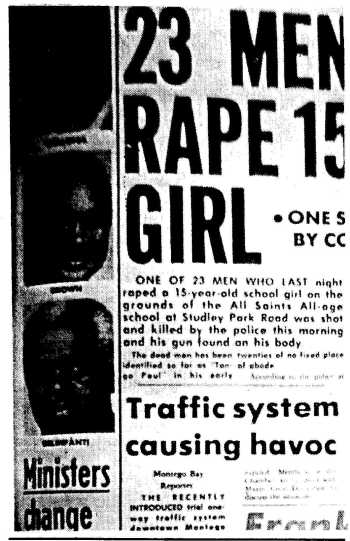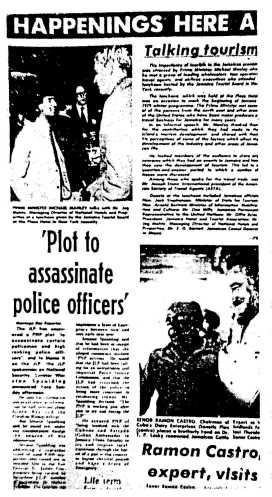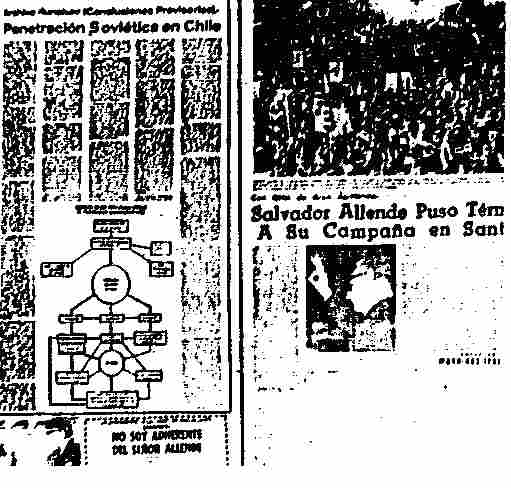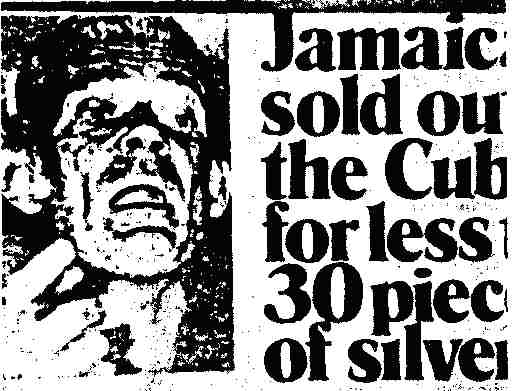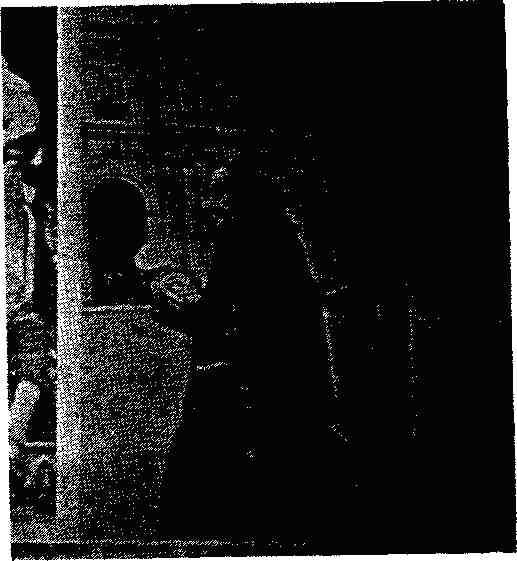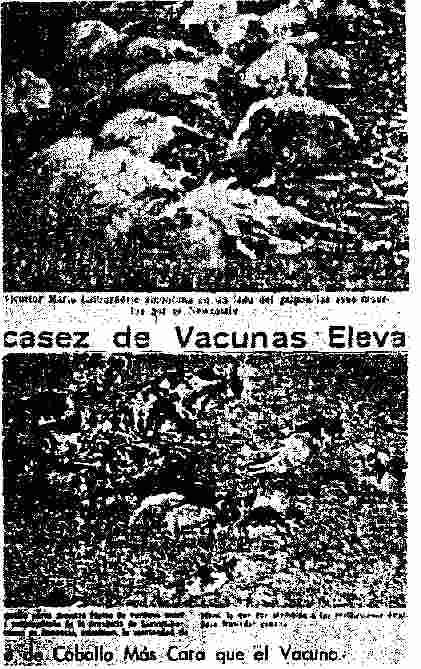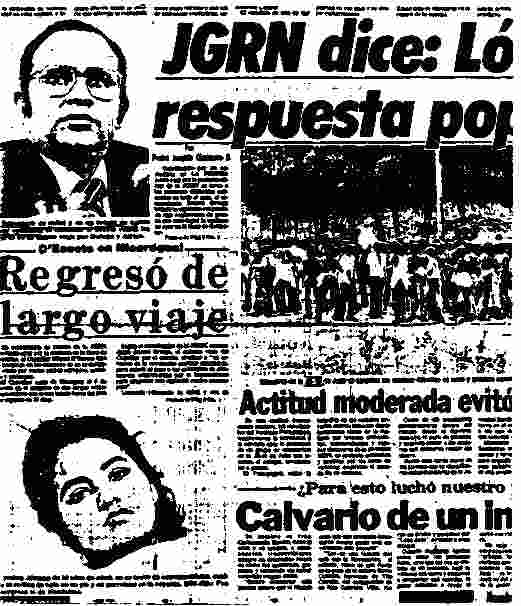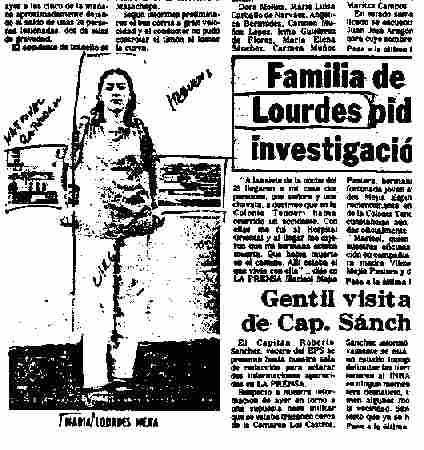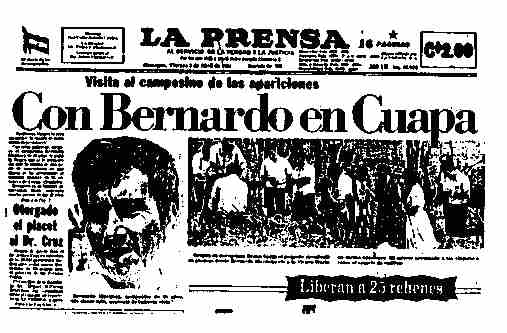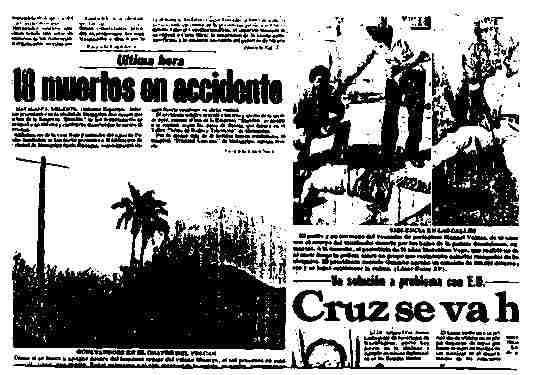CIA Media Operations in Chile, Jamaica, and Nicaragua
by Fred Landis
Covert Action Information Bulletin Number 16, March 1982, pp. 32 -- 43.
In the last decade, four American nations have chosen a socialist road to development -- Chile, Jamaica, Nicaragua, and Grenada. In the first three cases the CIA responded, among other actions, by virtually taking over the major newspaper in that country and using it as an instrument of destabilization. (Grenada closed the opposition newspaper shortly after the revolution for failure to comply with local ownership laws.)
The appropriation of newspapers by the CIA proceeds through certain discrete, identifiable stages. These include: using an international press association, firing many of the staff, modernizing the physical plant, changing the format of the front page, using subliminal propaganda, assassinating the character of government ministers, promoting a counter-elite to replace the socialist government, spreading disinformation, using divisive propaganda to create artificial conflicts within the society, dusting off stock CIA stories and themes, coordinating the propaganda effort with an economic, diplomatic, and paramilitary offensive, and generally following the blueprint for psychological warfare as outlined in the U.S. Army Field Manual of Psychological Operations.
The stages the CIA embarks upon in taking over a newspaper, combined with the drastic changes of the front page, are so specific that it is possible to identify the Agency's hand in the effort. When the propaganda offensive is coordinated with economic sabotage, paramilitary terrorism, and other psychological activities using known CIA fronts, one can state positively that a covert operation is underway.
The CIA has access to over 200 newspapers, advised by its World-Wide Propaganda Guidance Desk, which issues a "Bi-Weekly Propaganda Guidance" to every CIA station, for use in dealing with local media contacts. There is a continuing propaganda effort precisely to avoid crises like Chile, Jamaica, and Nicaragua. The purpose of this article is to describe what a CIA newspaper looks like during a crisis.
I first learned about the CIA's propaganda methodology in Chile in 1973 while I was working on a Ph.D. dissertation on changes in the mass media during the Allende period, especially the newspaper El Mercurio. About a year later, the Senate Intelligence Committee chose Chile as a case study of CIA covert action. For the first time, the U.S. government would give official status to a report on CIA covert activity. Also for the first time there were several former CIA analysts on the Congressional investigative staff familiar with CIA methods, who knew exactly the right questions to ask. With copies of my dissertation in hand, they went to CIA Headquarters to ask about Chile. Subsequent studies of CIA covert operations make frequent reference to Chile, and articles on the CIA and the media rely heavily on the case of El Mercurio.
During subsequent years I monitored several Latin American newspapers but saw nothing like the El Mercurio of 1970 -- 1973. Then in 1980, the Jamaica Daily Gleaner underwent the same metamorphosis. The Jamaican Press Association launched an investigation focusing on traditional areas of journalistic concern: the firing of journalists from the Daily Gleaner, the systematic appearance of fabricated stories, and the violation of traditional ethics of the profession. I was invited to testify before a Commission of Inquiry and explained that these changes were a by-product of the CIA taking over the newspaper. The Press Association issued a 32-page summary of my testimony in booklet form entitled "Psychological Warfare in the Media: The Case of Jamaica."
In May 1981 I helped the Union de Periodistas de Nicaragua with a similar report which appeared in installments in the newspaper Barricada July 8 - 22. The methodology to be discussed here can also be found in my dissertation, "Psychological Warfare and Media Operations in Chile: 1970 - 1973;" "Covert Action," Volume 7 of the 1975 Hearings of the Senate Church Committee; "The CIA and the Media," 1977 - 1978 Hearings of the House Intelligence Committee; and the above-cited reports of the Jamaican and Nicaraguan Press Associations.
Contents
- 1 The Methodology
- 2 Subliminal Propaganda
- 3 IAPA-CIA Collaboration
- 4 Disinformation
- 5 Channels of Disinformation
- 6 Symbols
- 7 The "Semantic Differential"
- 8 Subliminal Methods
- 9 Counterrevolution and Animal Farm
- 10 Divisive Propaganda -- The Manipulation of Religious Symbolism
- 11 Symbolism of the Cross
- 12 Campaign Coordination
- 13 Conclusion
The Methodology
The first step of the process is to elevate the owner of the target newspaper to the Board of Directors of the CIA-influenced Inter American Press Association. The December 26, 1977 New York Times quoted a high CIA official referring to IAPA as "a covert action resource" of the Agency. Next, IAPA lists the country in question as one in which freedom of the press is threatened. The Technical Services Division of IAPA is sent to "modernize" the newspaper. These "technical" improvements nearly always include getting rid of the typesetters, whose union is usually leftist in Latin America. Most of the editorial staff, even including some conservatives, is fired.
The style of the front page of the newspaper is changed dramatically, from that of the conservative London Times to that of, for example, the sensationalist New York Post. Screaming headlines and huge photos on related themes replace the previous randomness of unrelated news stories. The usual conservative newspaper in the Third World emphasizes what is happening in Europe and the United States. But in a media operation, local news suddenly takes over. Local catastrophes become the only image of the world -- a dark, frightening, and claustrophobic place.
Headlines in a newly CIA-influenced newspaper have an exclusively negative nature, blaming the socialist government for all the ills which suddenly befall the country. Where sufficient local problems cannot be manufactured, stories from other times or other countries are made into "news" in order to further a given theme: "Economic Collapse in Cuba;" "Economic Collapse in Poland;" "Economic Collapse in Nicaragua." The front page looks more like a political poster than a newspaper. The "news" is a carefully selected collage pushing a few simple themes, aimed at discrediting the government and creating divisions among the population.
The first theme is economic chaos, because this is the easiest for the U.S. to create. Foreign aid is cut off; the Inter-American Development Bank and the World Bank cut off loans; private U.S. banks cut off loans; spare parts for U.S.-manufactured machinery are denied.
The next theme is social chaos. In almost every country there are bizarre incidents which a conservative newspaper normally will not touch. Suddenly this National Enquirer-type material fills the front page: Violence, chaos, permanent crisis, unnatural events, omens from heaven, death, gruesome food stories, household pets who eat their masters, children who inform on their parents, servants who turn on their employers, etc. The difference is that after creating a climate of tensions, this situation is blamed on the government: First on the ideology that the government represents (socialism) and then on the government itself; first by insinuation and then explicitly; first with humor and then with terror; first with character assassination and then with physical assassination.
Strategically, the attack on government ministers proceeds like a chess game in which one eliminates the pawns and works up to the king. In Chile, there were no direct attacks on President Allende until all his Cabinet ministers had been individually ridiculed, isolated, discredited, and often forced to resign. In extreme cases, character assassination is followed by physical assassination, as was the case with three successive Chilean Ministers of Defense, Rene Schneider, Carlos Prats, and Orlando Letelier.
Subliminal Propaganda
Indirect attacks on government ministers employ the juxtaposition of photos of the targeted official with unrelated headlines, subliminal propaganda, and pre-selected word associations.
In the December 5, 1980 La Prensa in Nicaragua, a photo of FSLN leader Humberto Ortega is adjacent to a photo of a mutilated body. Connecting them is an official Sandinista police badge allegedly found near the body.
During the 1980 election campaign in Jamaica, the Daily Gleaner placed the photos of three cabinet ministers over the headline "23 Men Rape 15-Year-Old Girl." The entire page was carefully laid out to produce shock effect. Reading the story carefully it becomes clear that the photos have nothing to do with the headline; but the emotional shock effect has been accomplished.
Sometimes a semantic association will be involved. On September 25, 1972, El Mercurio subliminally associated the rape and murder of a schoolgirl with the Minister of Education. Seven years later in Jamaica, photos of Anthony Spaulding, the Minister of Housing, were placed next to photos of and headlines about houses burning down.
This practice of destroying the moral authority of "enemy" leaders by pictorial insinuation derives from experimentation during World War II in the production of propaganda leaflets. The U.S. Army Field Manual of Psychological Operations (FM 33-5), in the section dealing with the preparation of psychological warfare leaflets, recommends the use of pictorial or graphic insinuation as being more effective among a local population than direct attacks on their leaders, which might be met with resentment and rejection. Paul Linebarger, the Godfather of modern CIA media operations, placed great emphasis on the success the U.S. encountered when the psychological warfare leaflets were prepared in the style and format of a German newspaper. Linebarger studied both Allied and Axis propaganda efforts and concluded that the British were superior, because they disguised their propaganda as news.
Among radio, TV, and newspapers, the highest credibility is accorded the print media. Conservative newspapers have higher credibility among all social classes in Latin America than government newspapers, newspapers openly identified with a political party, or populist rags. This helps to explain why, in the three cases examined here, the CIA took over the major conservative newspaper in each country.
The reason the new front page resembles a psychological warfare leaflet is because it is a psychological warfare leaflet. The historical progression is clear. First the U.S. Army Propaganda Battalion produced leaflets which attacked enemy leaders by pictorial insinuation. Next, leaflets were prepared in the style and format of an enemy newspaper. Today, the CIA simply takes over the newspaper itself.
The reason a CIA-influenced newspaper changes its front page into a psychological warfare leaflet has to do with the enormous effect which this type of activity is deemed to have. An indication of this magnitude is given in The War on The Mind, by British sociologist Peter Watson, wherein he points out that in the single month of May 1968, three hundred million PSYOPS (U.S. Army Psychological Operations) leaflets were dropped on Vietnam. According to Paul Linebarger, several billion PSYOPS leaflets were dropped by the U.S. in the German theater of operations alone. Given the personnel needed to print the leaflets and fly them over enemy territory, it is surprising that so little has been written on the subject.
IAPA-CIA Collaboration
At least during World War II, with bombers dropping the leaflets, the source was evident. Today, the mastheads of the conservative newspapers are used to disguise the real source.
IAPA stands ready, with all its hundreds of cooperating member newspapers, to scream "Marxist Threat to Free Press" if any attempt is made by the target government to restrict the flow of hostile propaganda. In 1969 the CIA had five agents working as media executives at El Mercurio, all of whom in subsequent years were elevated to the Board of Directors of IAPA. The owner of El Mercurio was made head of the Freedom of the Press committee, and later President. IAPA bylaws permitted only working owners to be members, so the bylaws were changed to accommodate him. Then many of the CIA operatives at Copley News Service were made members of the Board of Directors of IAPA. Immediately before the campaign to oust socialist Prime Minister Michael Manley, Jamaica Daily Gleaner publisher Oliver Clarke was added to the Executive Committee; he has now been promoted to Treasurer. At the last annual convention in San Diego, IAPA elevated Pedro Joaquin Chamorro, Jr., to its Board of Directors. At that time he was not an editor or publisher of La Prensa, but the CIA needed him because he had the same name as his martyred father. After his elevation he was belatedly made Assistant Director of La Prensa, and when he was recently added to the IAPA Executive Committee, La Prensa began carrying the IAPA membership credential in its masthead. At the last IAPA meeting in Rio de Janeiro in October, speeches, including those by Vice-President Bush, were dominated by alarmist references to the situation of the press in Nicaragua.
Obviously the owner of a conservative newspaper in Latin America does not need CIA money to be against a socialist government. The assistance provided by the CIA is primarily technical, not financial. Without CIA help, the local newspaper's opposition would be openly stated on the editorial page in language reflecting the ideology of the local conservative elite. That would be ideological warfare, not psychological warfare. But the CIA is not concerned, in these operations, with local ideology; it is concentrating on the use of its bag of technological dirty tricks. One of these tricks is disinformation.
Disinformation
Disinformation is a special kind of "black" propaganda -- the CIA's term for the use of false information -- usually supported by forged documents. CIA practice in this area is discussed in a recent article in The Nation, "Foreign Policy By Forgery "(April 11, 1981), by Ralph McGehee, a 25-year veteran CIA analyst. Despite CIA censorship and even after numerous deletions, the article notes:
- "Where the necessary circumstances or proofs are lacking to support U.S. intervention, the CIA creates the appropriate situations or else invents them and disseminates its distortions worldwide via its media operations . . . Disturbed at the Chilean military's unwillingness to take action against Allende, the CIA forged a document purporting to reveal a leftist plot to murder Chilean military leaders. The discovery of the 'plot' was headlined in the media and Allende was deposed and murdered. There is a similarity between events that precipitated the overthrow of Allende and what happened in Indonesia in 1965. Estimates of the number of deaths that occurred as a result of the latter [word deleted; probably "deception"] operation run from a half million to more than one million people. ..."
The principal disinformation agent involved in the Chilean deception was Robert Moss, who seven years later co-authored The Spike, arguing that the Soviets had invented this strange technique called disinformation. First Moss wrote of a secret army of Cubans in Uruguay. After the military coup in Uruguay, he claimed there was a secret army of 14,000 Uruguayan, Bolivian, and Cuban leftists in Chile. After the Chilean coup, Moss discovered a secret army of 5,000 Chilean leftists in Portugal. On October 8, 1979, Moss wrote in the London Daily Telegraph that there was a secret army of 5,000 Cubans in Jamaica. This article was reprinted in the Jamaica Daily Gleaner under the headline "Castro Plans to Make Jamaica an English-Speaking Cuba." According to the Jamaican government, there were only 420 Cubans in Jamaica, most of them teachers, doctors, and agricultural experts. In the August 10, 1981 Daily Telegraph, Moss discovered yet another 5,000 Cubans "deployed" in Nicaragua.
Psychological operations may be divided into two principal types according to purpose: stability operations and destabilization. In the case of a government considered friendly, CIA propaganda is designed to create a positive image of that regime and in general to support its stability. In previous articles in CAIB, we have cited the examples of Arnaud de Borchgrave's defense of the Shah of Iran and Robert Moss's fulsome praise of the Chilean Junta.
Destabilization is a word which entered world currency when former CIA Director William Colby used it to describe what the CIA had done to Chile. Destabilization means that having studied the glue that keeps a society together, one then uses that knowledge to make that same society come unglued. Among the methods used, according to the Manual of Psychological Operations:
- "To stimulate dissension between military and political estates; to undermine confidence in leadership; to encourage disaffection on the part of religious, ethnic, political, economic and other elements, against the government or against each other; to make friendly leaders stronger and enemy leaders weaker."
Channels of Disinformation
The mere appearance of divisive propaganda, "black" propaganda, and disinformation is prima facie evidence of a psychological operation run by a hostile intelligence agency. One of the methods for determining when it is a CIA operation is to trace the hidden channels for moving disinformation into the target country. I call this process the circulation of non-news or the laundering of "black" propaganda. As described by Philip Agee:
- "For example, the CIA station in Caracas can cable information on a secret communist plot in Venezuela to the Bogota station which can 'surface' through a local propaganda agent with attribution to an unidentified Venezuelan government official. The information can then be picked up from the Colombia press and relayed to CIA stations in Quito, Lima, La Paz, Santiago ..."
If done properly, it is very difficult to trace any of this activity to the CIA. First, the "black" propaganda item is laundered through a reputable news organization in order to disguise the source. Then CIA proprietary news organizations move the story around -- the circulation of non-news. One clue in uncovering this technique is the attribution of a sensational news story to a far-away source. In the above example, how could a Colombian newspaper be the first to know about a secret plot in Venezuela?
Let us examine a recent fake headline in La Prensa to illustrate the laundering of "black" propaganda. On August 16, 1981 La Prensa headlined that Nicaraguan Chancellor Miguel D'Escoto had gratuitously insulted the Catholic Church. D'Escoto categorically denied having made any such statements. La Prensathen said its source was the Miami-based El Diario de las Americas. This is a Cuban exile newspaper which shares office space with IAPA, and which has a number of CIA agents on its staff. El Diario 's head, Horacio Aguirre, is the new President of the IAPA Executive Committee. El Diario de las Americas in turn attributed the source of the alleged D'Escoto interview to an obscure Mexican newspaper, El Periodico, which at the time it carried the interview had been in existence only a short time. It claimed as its source a taped interview made six months previously by one of its reporters in New Delhi. How can a fledgling Mexican newspaper afford to send a reporter to New Delhi? How do they manage to make an eight-column headline out of an interview that allegedly took place six months earlier? When challenged by D'Escoto to produce evidence of such an interview, the reporter claimed that the tapes were garbled, as his batteries had run out.
Symbols
Perhaps the most specific feature of a CIA-controlled newspaper is the abandonment of any attempt to convey its message in the text, and its reliance instead on a few key symbols planted on the front page. The symbols manipulated are those which have strong emotional associations for the target group. By simply placing the key word near a photo of government leaders, a crude behaviorist attempt is made to condition new associations and new values to familiar personalities.
For the purpose of identifying this kind of propaganda in the following analysis, the items discussed are from the front page only, and within that page headlines, photos, and captions under photos:
In the middle of the page are three photos of a government leader with a convenient name, Cruz (cross); below there is the headline "Peace Corps Is Leaving." The three photos of Cruz and the caption under the photos all say "cross" over that headline. The message thus repeats the association, "cross is leaving," "peace is leaving." The headline "Peace Corps Is Leaving" was a fraud, in fact, there being no Peace Corps operation in Nicaragua at that time to leave. The leftist press considered the fake headline to be a provocation and ignored the emotional manipulation of cross and peace. In my dissertation there is an entire section devoted to fake headlines in El Mercurio. Only later did I realize that all the illustrations used were adjacent to photos of government leaders.
For three years President Allende's picture appeared rarely in El Mercurio, but whenever it did it was always next to headlines which included the words Soviet, communist, Marxist, violence or death.
Several other examples, which cannot be illustrated here due to space limitations, can be noted: The August 28,1970 El Mercurio had a photo of Minister of the Economy Pedro Vuscovic next to a huge photo of a noose hanging over a baby's head with the headline "Wanted to Strangle This Baby." The June 12, 1972 El Mercurio has another picture of Vuscovic next to a headline "Mother Raped, Assassinated."
The March 31, 1980 Daily Gleaner carried a photo of Michael Manley next to two unrelated headlines, "Dark Future," and "Reds Took Over." The January 6, 1976 Daily Gleaner (during the election campaign) had a photo of Manley next to an unrelated headline, "Policeman, Two Others Shot." This was repeated in the January 6, 1978 issue which carried a photo of a dead policeman with the related headline "Policeman Shot," next to an unrelated article about Manley, entitled "A Cadillac for the Prime Minister."
By the simple juxtaposition of photos with unrelated headlines, government leaders in socialist countries and the ideology they represent are associated with death, plagues, and violence. The new El Mercurio-Daily Gleaner-La Prensa are more similar to each other than to their old conservative formats. The immediate reaction of people when shown examples is that the pattern is clear, but how does one know it works? In fact, it has long been an article of faith among the "small effects" communications theorists that propaganda of any kind has little demonstrable effect on voting and similar political behavior. This unwarranted assumption was being repeated by an unwitting southern Congressman to Dr. Frederick Frei of the Massachusetts Institute of Technology. The Representative was arguing against funding propaganda on the ground that no substantive benefits to the national security derived from such activities. Dr. Frei revealed, however, that actual studies conducted in Chile and Turkey proved the contrary. From the undeleted portions of the censored testimony it was clear that Dr. Frei was referring to the 1964 Chilean elections when the CIA spent a reputed twenty million dollars to stop Allende. While Dr. Frei's testimony may have been self-serving, it can be taken as evidence of a CIA belief that their peculiar anti-Allende propaganda methods do work. In a book published in Venezuela in 1968, Interviene La CIA en Investigaciones Sociologicas en Venezuela, by Rodolfo Quintero, Frei was described as a CIA agent.
The "Semantic Differential"
Behavioral conditioning by highly selective, emotionally-charged words has come to be the most distinguishing characteristic of CIA propaganda, due to the influence of three men: B. F. Skinner, Charles Osgood, and Edward Lansdale.
During the days of the OSS, the CIA's predecessor, U.S. propaganda was heavily influenced by Freudians. Later the Pentagon and the CIA came to regard the views of B. F. Skinner as being more pragmatic. Skinner wrote a book called The Behavior of Organisms, based entirely on observing the behavior of white mice and pigeons.
Modern attitude theory is a branch of behaviorism which views the higher mental functions as explainable in terms of stimuli and response. A mental concept has logical associations, or meaning, and emotional associations, or affect.
Psycholinguists have long believed that the grammatical and semantic features of a given language shape the world view of its speakers. Merely by studying the language of a culture it should be possible to uncover hidden psychological processes peculiar to that culture. If, in addition, one analyzed such matters as characteristic word associations and the emotional associations of certain key words, one could use psycholinguistics to prepare psychological profiles not only of cultures but also of individual leaders.
Professor Charles Osgood, whose research was funded by the CIA and used in the Agency's MK-ULTRA program, developed a technique called the "semantic differential" which can do all of the above.
Edward Lansdale, a notorious veteran of both the OSS and the CIA, glorified in The Ugly American, operated on the philosophy that in each foreign culture there was some hidden psychological key which, if discovered, would permit the minds of the people to be easily manipulated.
In 1958 the semantic differential became the official method chosen by the CIA to search for this hidden key. Twenty years later the CIA released boxes of previously classified records covering its MK-ULTRA experiments in the field of psychological and mind control research. Based on these documents, John Marks wrote in The Search for the "Manchurian Candidate": The CIA and Mind Control:
- "Agency officials saw his research as 'directly relevant' to covert activities. They believed they could transfer Osgood's knowledge of 'hidden values and cues' in the way people communicate into more effective overseas propaganda. Osgood's work gave them a tool called the 'semantic differential' -- to choose the right words in a foreign language to convey a particular meaning." [In 1958 the CIA gave Osgood $192,975 to finance a world-wide study of 620 key words in 30 cultures using the semantic differential.]
The reason for dwelling at such length on the topic of the semantic differential is that it explains a host of phenomena unique to CIA propaganda: why certain words are used and others are not; the use in propaganda of words that sound like communism; the attempt at behavioral conditioning of previously positive terms into negative ones by simple physical association; the projection of a highly-polarized world view in which the government is depicted exclusively in terms that reflect not only the expected negative attitude, but also impotency and passivity.
By 1974 I had concluded that whoever was running El Mercurio was using the semantic differential. Interestingly, it was Charles Osgood himself who agreed with this analysis and helped me to prove it. The voluminous MK-ULTRA records released by the CIA in 1978 confirm that the semantic differential is the strategic intelligence on which CIA propaganda targeting is based. It is to CIA psychological warfare the equivalent of the inertial guidance system of an atomic missile.
Subliminal Methods
The combined effect of word associations (derived from the semantic differential) with subliminal imbeds is so strong that it displaces any other message.
The intense psychological and physical fear aroused in viewers of the film The Exorcist is notorious. Not as well known is the fact that these reactions were the result of the use of very strong subliminal messages, in particular of a death mask. The subliminal use of the death mask in The Exorcist has been widely discussed in many publications. It should be noted that William Peter Blatty, the author, has stated that he was involved in psychological warfare operations in Viet Nam.
As described in Media Sexploitation, by Wilson Brian Keys, The Exorcist was "a brilliant repertoire of visual and auditory subliminal innovations... There is no possibility of rational decision making or defense, since consciousness is bypassed completely. Numerous times during the movie there was a flash of light and the face of Father Karras momentarily appeared as a large, full-screen death mask apparition... At the movie's climax, when Father Karras was possessed by the devil, his face turned white -- closely resembling the tachistoscoped death mask."
During the 1980 Jamaican elections heavily retouched photos of Prime Minister Michael Manley looking like a death mask appeared in the Daily Gleaner. (Other examples can found in Psychological Warfare in the Media: The Case of Jamaica.)
Keys described the physiological impact of The Exorcist:
- "As tension within a person increases, he perceives less and less at the conscious level and becomes more and more susceptible to subliminal stimuli. . . . The tension and release, tension and release, tension and release, always building higher and higher and higher, induced exhaustion and even nausea for many in the audience."
What it feels like to be in a country like Chile or Jamaica during a period of intense psychological warfare is as if one were actually in The Exorcist instead of just watching it. Compare the above audience reactions with the following descriptions by visitors to Chile:
Baeza Flores, writing in Radiografia Politico de Chile: "I arrived like a traveller feeling a bit dizzy from the gas of propaganda and counter-propaganda of psychological warfare, a little seasick from the ideological gas."
Oscar Waiss, writing in La Nacion: "The purpose of the CIA is to create a national psychosis, including an insane repetition of themes, which could serve as background music for a horror film."
Ralph McGehee stated in his Nation article that the CIA attempted to recreate the same psychological mood in Chile as it had in Indonesia in 1965. Note what a newspaper reporter in Djakarta, Arnold C. Brackman, writing in The Communist Collapse in Indonesia, later wrote about this mood: "In 1964-1965, this community was subject to 'mental terror, 'the popular phrase used by articulate Indonesians to describe the period.... The murders can be characterized as a 'psychological explosion' among a repressed people who had suffered 'mental terror.' "
What the CIA unleashed in Indonesia was a psychological warfare bomb that killed more people than the atom bomb at Hiroshima. It is this demonstrated ability to create emotional tidal waves and political earthquakes that warrants a careful examination of CIA psychological operations.
On April 8, 1972 El Mercurio placed a full color photo of open heart surgery next to a photo of Allende. This is not the sort of thing that Chileans had come to expect with their morning coffee. On November 24, 1972 El Mercurio improved on the original by surrounding Allende's photo with four color photos showing the implantation of a radioactive battery in a Chilean heart. The imagery which is intended here is that of (the Marxist) Allende, like the radioactive implant, as an alien element which has penetrated into the very heart of Chile. In this organic model, Chile is a healthy body which will eventually reject the alien Marxist implant (Allende).
On August 13, 1973 -- one month before the coup -- El Mercurio lifted an omen out of Bergman's The Seventh Seal. A sepulchral hag done up in a hooded monkish robe shuffles in front of the Presidential Palace clanging cymbals. El Mercurio manages to catch this omen of death come knocking on the door just as it arrives at the portals of La Moneda.
On March 9, 1972 El Mercurio presented another photo of Minister of the Economy Pedro Vuscovic; just below: jaws -- the hideous face of a growling attack dog jumping straight at the camera. On August 2, 1972, and for several preceding days, El Mercurio manipulated other omens of death in the form of dead cows and chickens. This was coordinated with the distribution of movies and comic books prepared by the CIA based on George Orwell's Animal Farm.
Counterrevolution and Animal Farm
The symbolism of dead cows surfaced anew in La Prensaof Nicaragua in April and May of this year. Animal Farm was printed in installments on the editorial page of La Prensa, and every vendor had free copies of the comic book to distribute. According to E. Howard Hunt in Memoirs of an American Secret Agent, one of his responsibilities while with the CIA was to arrange for the production and distribution of the film version of Animal Farm. In its comic book view of the world, a socialist country is a farmyard in which the pigs have taken over and the victimized citizenry are depicted as cows and chickens. The pigs get fatter while the cows get thinner.
The movie Animal Farm is a good example of the advantages of psychological warfare over explicit ideological propaganda. Animal Farm has no explicit political message. It is a simple allegory involving familiar farm animals. In a country like Nicaragua, it is a way of reaching individuals who may be illiterate or apolitical with a very strong counterrevolutionary argument. Its central theme is the futility of revolution. The new pigs are just as bad as, and end up looking like, the old master. The hypocrisy of revolutionary rhetoric; the cynicism, greed, and lust for power of revolutionary leaders; all culminating in slave labor, show trials, starvation and death. The CIA does not say Nicaraguan government leaders are pigs; it shows Animal Farm and lets people make their own analogies. In the event the desired analogies are not made, the local newspaper will retouch photos of leaders making them look like pigs, contrasted with photos of victimized and emaciated citizens.
On March 18, 1981 La Prensa featured a photo of Chancellor D'Escoto taken at a very odd angle, which, together with added shadows, emphasized his double chin. The title under the photo reads, "Overflowing With Health and in a High State of Optimism," contrasting sharply with the photo below, of a victimized citizen lying on a hospital bed, with the headline, "Calvary of an Innocent. Is This What Our People Fought For?"
In May 1981 La Prensa began a campaign (later retracted) alleging that cows brought from Cuba had hoof-and-mouth disease. Although no evidence was ever offered in support of these allegations, it skillfully combined the imagery from Animal Farm with the already established association of the (Marxist) government with plagues and death.
Divisive Propaganda -- The Manipulation of Religious Symbolism
The purpose of a CIA campaign of divisive propaganda is to reduce national unity. In April 1981 a major campaign of psychological warfare began in Nicaragua with an attempt to mobilize protests by Catholics against the government. The first step was to inflame the parents of students attending parochial schools. A La Prensa campaign attacked and polarized democratic nationwide forums to discuss educational reform by using such terms as "Marxist brainwashing," "turning children into guerrillas," "filling children with hatred," "priests who support the Marxist government and betray their allegiance to the True Church," etc.
The manipulation of religious symbolism, especially that of the cross and of the Virgin, was initiated by La Prensa and the CIA, not by the Nicaraguan Catholic Church. Although the clear intention of the propaganda campaign was to polarize relations between Church and State, the religious tone which the political struggle acquired was not created by the Church. Alan Riding, in a New York Times article of May 29, 1981, entitled "Religion Becomes a Political Weapon for both Left and Right in Nicaragua," unwittingly bolstered the CIA line:
- "Thousands of Nicaraguan Roman Catholics trekked to the small village of Cuapa, 100 miles east of here, where the Virgin Mary is said to have appeared.... 'The cult of the Virgin of Cuapa is a response to the fears of Communism,' a foreign priest said."
Before a "miracle" can occur, the way must be prepared. The first recorded CIA plan in this area was by Edward Lansdale. A witness before the Senate Intelligence Committee investigating alleged assassination plots described the plan:
- "I'll give you one example of Lansdale's perspicacity. He had a wonderful plan for getting rid of Castro. This consisted of spreading the word that the Second Coming of Christ was imminent and that Christ was against Castro. And you would spread this word around Cuba, and then on whatever date it was, that there would be a manifestation of this thing. And at that time -- this is absolutely true -- and at that time just over the horizon there would be an American submarine which would surface off Cuba and send up some starshells. And this would be the manifestation of the Second Coming and Castro would be overthrown. Well, some wag called this operation 'Elimination by Illumination.'"
Nicaragua began to be illuminated at Christmastime. La Prensa of December 28, 1980 carried the photograph of a young lady with the convenient name Maria Lourdes. Maria was photographed in white raiment against the heavens in the shape of a cross. La Prensa found the only spot in Managua where the entire National Cathedral can be shown in the background. She appears as a statue of the Virgin descending from the heavens upon the National Cathedral. The word "Lourdes" borders the photo on each side. Mary, Angel, Heaven, Lourdes, Cross, National Cathedral. . . it is impossible to imagine more heavily-loaded religious symbols being squeezed into one photograph.
On April 1, 1981, a day favored by pranksters, La Prensa began the creation of a local Lourdes. They mobilized thousands of the devout to a spot where the Virgin Mary had appeared to a simple shepherd and a La Prensa reporter while praying in a circle of roses (rosary). The shepherd's name was Bernardo (echoing the Song of Bernadette). According to the CIA's newspaper, the Virgin was not happy with current affairs in Nicaragua.
Symbolism of the Cross
U.S. Army Field Manual of Psychological Operations: "142 Symbols
- Among Christians the power of the Christian cross is effective as a symbol because it graphically represents Christ's suffering and death for man."
When La Prensa wishes to turn the front page into a religious tableau, it begins by running a headline about the Nicaraguan Ambassador to the United States, Dr. Arturo Cruz, never using the title Ambassador, or Doctor, or his other names in order to leave the symbolic "Cruz" (cross). Within a few inches of "Cruz" appears a Christ-like figure and a cross.
The May 9 photo, apart from its association with Cruz, is very interesting. It shows a pastoral scene with happy young people strumming guitars. The CIA distributed a half million copies of a very similar photo in Italy before the 1976 national elections. The thematic content is also the same, where the beatific scene of Christian folk singers is contrasted with code-words for Marxist youth: hatred, materialism, political, conflict.
The Italian version was distributed as ads in the Milan-based newspaper, Avvenire and Il Giornale Nuovo, and as a pamphlet attributed to the organization "Communione e Liberazione," identified in the House of Representatives' Pike Commission Report as a recipient of CIA funding. On election day a new version appeared in which was added the symbol of the Christian Democratic Party (a cross over a shield) and an exhortation to Catholic youth to vote for that political party and against Marxism.
During the 1970 Chilean elections, the same photographic and thematic content appeared in ads for an organization calling itself "Nueva Accion Cristiana"(New Christian Action). An investigation by the Chilean Chamber of Deputies established that this was an illegal, unregistered, non-existent organization invented by executives at El Mercurio. This front was incorporated in an ad hoc advertising agency called Andalien, which was shown to have received CIA funds, and whose executives were later identified as CIA agents.
On June 18, 1980 the Jamaica Daily Gleaner's front page was dominated by a photo of an open Bible, an arrow indicating where a bullet was lodged. The headline read, "The Bullet and the Bible." Readers were asked to believe that a simple Christian farmer was reading his family Bible when suddenly a communist bullet came whizzing through the window, headed straight for his heart. Personally I prefer Woody Allen's version. He claims a Jesus Freak assaulted him with a Bible which was stopped by a bullet he carried in his vest pocket.
Some time later the Daily Gleaner ran a photo of a huge egg covered by an amorphous black spot. The story was that a good Christian farmer found the egg in his chicken coop and brought it to the offices of the newspaper as an oddity. The Gleaner was able to identify the mess on the egg positively as a map of the Soviet Union, and the appearance of the magic egg was said to be an omen from God to the people of Jamaica that they should not let their country be turned over to the Soviets.
Campaign Coordination
All of this should not suggest that the CIA just plays games with foreign newspapers. The internal propaganda campaign is coordinated with an economic, diplomatic, and paramilitary offensive. Eventually, the economic chaos claimed in the propaganda becomes real. Suddenly there really are shortages. Then conflicts develop with bordering states, ancient racial and religious divisions suddenly flare up, communications and transportation are sabotaged.
In Nicaragua, the appearance of the Virgin coincided with the arrival of Morris Zerulo, a right-wing American evangelist, amidst a massive publicity campaign touting his alleged ability to exorcise the demons afflicting Nicaragua. The U.S. cut off economic aid. The State Department accused Nicaragua of fomenting insurgency in El Salvador. Former CIA Deputy Director Vernon Walters visited the hostile neighboring states. Incursions by former Somoza guards across the Honduran border increased, while these same mercenaries were openly trained in the United States. Thousands of Catholics were mobilized against the government and pressures were exerted on the priests serving in the Sandinista administration to resign.
During the 1980 electoral campaign in Jamaica, the character assassination of government ministers in the Daily Gleaner was coordinated with actual assassination plots against Prime Minister Michael Manley, Minister of National Security Dudley Thompson, and the General Secretary of the Peoples National Party, Dr. D. K. Duncan. Fake headlines about Soviet planes and Cuban boats landing were coordinated with a real paramilitary terrorist campaign that claimed some 700 lives. A serious but little publicized coup attempt occurred in June 1980. U.S. companies closed. U.S. economic aid, public and private, was unobtainable.
On October 1, 1972 the CIA organized the Chilean truck owners to paralyze transportation. The CIA-dominated Inter American Press Association held its annual convention in Chile to investigate the perceived threat to El Mercurio. U.S. warships participating in Operation Unitas appeared off the coast of Valparaiso giving symbolic support for dissident military units to act. CIA sabotage squads began blowing up bridges, railway lines, and people. El Mercurio called on the armed forces to save Chile.
Conclusion
The stages of psychological warfare are well defined. In fact, the U.S. Army issues Field Manuals for each stage. Interestingly, the primary responsibility for planning and conducting the activities discussed in the first stages does not lie with the military. Like James Bond's license to kill, only the CIA is supposed to engage in "black" propaganda, forging of documents, paramilitary actions, and other such covert operations. [During the early 1970s, however, the U.S. Army was found to have engaged in massive political spying in Europe. This conduct was ruled unlawful by a Federal court.] The ultimate military objective only becomes evident in the later stages. Psychological warfare is a form of secret unconventional warfare which may, if all else fails, shift to open conventional warfare.
While the terminology varies among different agencies, the Army's somewhat archaic terms for the stages are: Propaganda, Psychological Operations, Psychological Warfare, Civil Affairs, and Reconstruction.
Propaganda consists of presenting a positive image of the U.S. and a negative image of the socialist bloc. The CIA cooperates to some degree in this effort with the U.S. International Communications Agency, soon to be renamed, as before, the U.S. Information Agency.
Psychological Operations take place in peacetime and are geared toward throwing elections or moderating the policies of a foreign government.
Psychological Warfare is undeclared war. All the agencies of the U.S. government coordinate their activities as a team, all resources of the U.S. short of overt war are brought to bear. Open and underground resistance groups are set up by the CIA. There is an attempt to mobilize the masses against the government. Paramilitary operations, including terrorism and assassination, are coordinated with subversive propaganda. While instigated by the CIA, their agents are primarily local people. The task is still to manipulate civilians or the military or both indirectly to overthrow their own government.
To arrive at the stage of Civil Affairs means that within the goals which have been set for the CIA by the President, they have failed. A conventional military coup is necessary or the Marines must be sent in. The principal actors here are regular military forces of the U. S. and of those elements friendly to the U.S.
In the Reconstruction stage, forces friendly to the U.S. are in undisputed physical control of the entire national territory. The country has been pacified. A think-tank of U.S.-trained economists, attorneys, and journalists is set up to advise the new pro-capitalist government. Ideally, the economy is restructured according to the theories of Milton Friedman, as in Chile.
Of those examples under discussion, only in Chile has the final stage been reached. That was because the CIA failed in its frenzied efforts to throw the elections of 1970 and 1973. In Jamaica the CIA suffered a defeat in the 1976 elections and came prepared for the 1980 campaign with both military and electoral options.
Contrary to the Chilean example, success was achieved for the CIA in Jamaica in the third stage, psychological warfare. That stage is currently well under way in Nicaragua. Timely and firm defensive measures, and particularly education of the populace to the nature of psychological warfare, can and will prevent a CIA success there.
- Fred Landis, a Chilean-born American psychologist, received his Ph.D. from the University of Illinois based upon his thesis, "Psychological Warfare and Media Operations in Chile, 1970 - 1973." He served as a consultant for the Subcommittee on CIA Covert Action in Chile of the Church Committee. He is the co-author, with Donald Freed of Death in Washington: The Assassination of Orlando Letelier (Lawrence Hill & Co.: 1980), and has contributed articles to many magazines, including the Covert Action Information Bulletin.
- This article reflects the content of a 30-minute color video movie produced by Landis entitled: "CIA Media Operations, A Study in Imagination and Perversity." Organizations interested in showing this film, together with a lecture by Dr. Landis, should contact him at P. O. Box 3068, Anaheim, CA 92803.
- Arturo Cruz, who was the Nicaraguan Ambassador to the U.S. when this article was written, has since resigned, but continues to support the Sandinista government.
Copyright © 1981 by Fred Landis.

